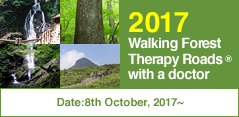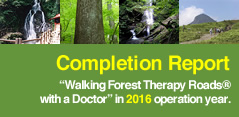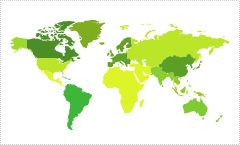1.Background
The forest environment has been enjoyed by man since ancient times because of the quiet atmosphere, beautiful scenery, mild climate, and clean fresh air in the forest.
As such, one can imagine that all of these qualities must offer some benefit to peoples’ mental and physical health, and that forests may hold great medical potential. We have discovered that this is true in the case of a Japanese activity called the Shinrinyoku, or a forest bathing trip (green shower trip). The Shinrinyoku is a short leisurely trip to a forest for therapeutic purposes.
However, there has not been sufficient medical evidence supporting the effects of the forest environment so far. In order to prove this hypothesis, the Ministry of Agriculture, Forestry and Fisheries of Japan initiated a research project beginning in 2004 to investigate the effects of forests on human health from a scientific perspective.
After 6 years, the project team has obtained a significant quantity of compelling data on Forest Medicine. The project team has found that The Shinrinyoku reduce the level of cortisol in saliva, decreases the level of urinary adrenaline and noradrenaline1, reduce blood pressure and reduce sympathetic nervous activity and increase parasympathetic nervous activity in humans. Moreover, visiting a forest, rather than a city area, increases human natural killer (NK) 2 activity and the expression of anti-cancer proteins and decreases the levels of urinary adrenaline and noradrenaline and cortisol in serum, and that the increased NK activity and anti-cancer proteins3 lasted for more than 30 days after the trip in both male and female subjects. Phytoncides4 released from trees and decreased stress hormone levels may partially contribute to the increased NK activity.
In addition, The Shinrinyoku involves a visit to a forest for the purpose of relaxation and recreation by breathing in volatile substances from plants (trees) such as alpha-pinene and limonene, called phytoncides. The Shinrinyoku has now become a recognized relaxation and/or stress management activity in Japan.
2.The Japanese Society of Forest Medicine to the International Society of Nature and Forest Medicine
Based on the background described above, the Japanese Society of Forest Medicine was inaugurated by researchers in Japan in March, 2007 at Osaka, Japan (http://forest-medicine.com/eindex.php).
The Japanese Society of Forest Medicine (JSFM) has held the following three Symposiums on Forest Medicine from 2007 to 2009:
1. ‘Verifying the effect of forest bathing trips from the scientific viewpoint’, March, 26, 2007 in Osaka, Japan
2. ‘The trends in research on forest bathing trips in Japan, Korea and around the World’, March 29, 2008 in Kumamoto, Japan
3. ‘The mechanism of the effect of forest environments on human health’, March 30, 2009 in Tokyo, Japan
In order to broaden understanding of the medical science it developed in Japan and works to spread to the international community, we decided to found the International Society of Nature and Forest Medicine (INFOM).
3.Purpose
The purpose of the International Society of Nature and Forest Medicine is to promote research on nature and forest medicine including the effects of forest and nature environments on human health in the global vision around the world.
The International Society of Nature and Forest Medicine will collaborate with the International Union of Forest Research Organization (IUFRO), and other related academic societies to carry out the study of forest and nature medicine, and the collection and editing of documents on the topic of forests and human health.
It is also to provide a platform for enterprises, universities and governments who are interested in the practice of nature and forest medicine for promoting the effective uses of forest resources on stress management, health promotion and the prevention and rehabilitation of diseases.
Notes:
- Stress hormones: Cortisol, adrenaline and noradrenaline are called stress hormones. These hormones in urine/saliva increase under stress status.
- NK cells: Natural killer (NK) cells are lymphocytes (very important immune cells), which provide host defense against tumors and viruses. We found that walking in forest significantly increased human NK activity and the level of anti-cancer proteins in NK cells.
- Anti-cancer proteins: NK cells kill target cells by the directed release of cytolytic granules that contain perforin, granzymes A/B and granulysin. Therefore, perforin, granzymes A/B and granulysin are called as anti-cancer proteins.
- Phytoncides: Phytoncides are antimicrobial volatile organic compounds derived from plants (trees). We found that phytoncide exposure significantly increased NK activity and the percentages of NK, perforin, granulysin, and granzyme A/B-expressing cells, and significantly decreased the concentrations of adrenaline and noradrenaline in urine.




